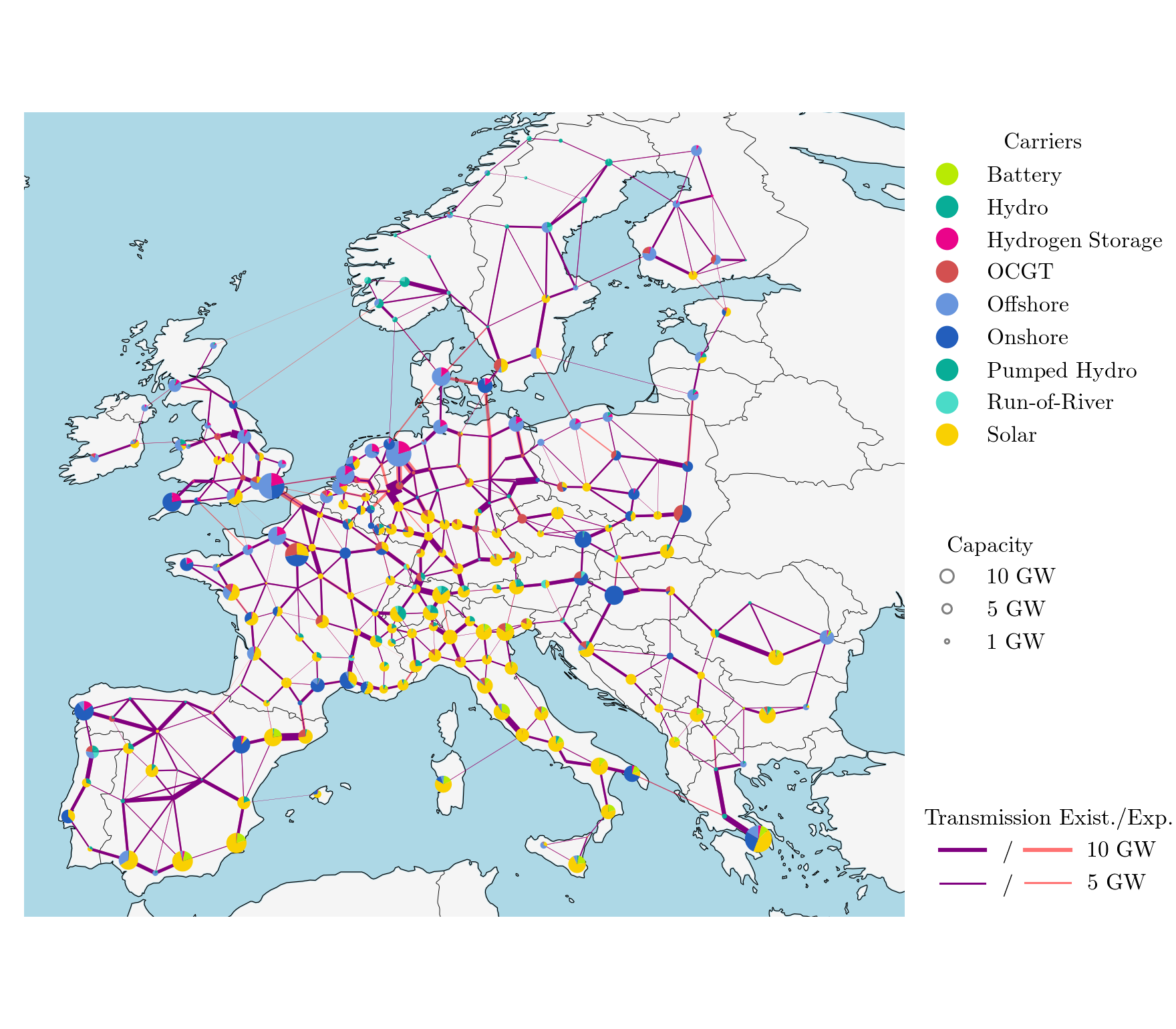PyPSA stands for "Python for Power System Analysis". It is pronounced "pipes-ah".
PyPSA is an open source toolbox for simulating and optimising modern power and energy systems that include features such as conventional generators with unit commitment, variable wind and solar generation, storage units, coupling to other energy sectors, and mixed alternating and direct current networks. PyPSA is designed to scale well with large networks and long time series.
This project is maintained by the Department of Digital Transformation in Energy Systems at the Technical University of Berlin. Previous versions were developed by the Energy System Modelling group at the Institute for Automation and Applied Informatics at the Karlsruhe Institute of Technology funded by the Helmholtz Association, and by the Renewable Energy Group at FIAS to carry out simulations for the CoNDyNet project, financed by the German Federal Ministry for Education and Research (BMBF) as part of the Stromnetze Research Initiative.
PyPSA can calculate:
- static power flow (using both the full non-linear network equations and the linearised network equations)
- linear optimal power flow (least-cost optimisation of power plant and storage dispatch within network constraints, using the linear network equations, over several snapshots)
- security-constrained linear optimal power flow
- total electricity/energy system least-cost investment optimisation (using linear network equations, over several snapshots and investment periods simultaneously for optimisation of generation and storage dispatch and investment in the capacities of generation, storage, transmission and other infrastructure)
It has models for:
- meshed multiply-connected AC and DC networks, with controllable converters between AC and DC networks
- standard types for lines and transformers following the implementation in pandapower
- conventional dispatchable generators with unit commitment
- generators with time-varying power availability, such as wind and solar generators
- storage units with efficiency losses
- simple hydroelectricity with inflow and spillage
- coupling with other energy carriers (e.g. resistive Power-to-Heat (P2H), Power-to-Gas (P2G), battery electric vehicles (BEVs), Fischer-Tropsch, direct air capture (DAC))
- basic components out of which more complicated assets can be built, such as Combined Heat and Power (CHP) units and heat pumps.
pip:
pip install pypsa
conda/mamba:
conda install -c conda-forge pypsa
Additionally, install a solver.
import pypsa
# create a new network
n = pypsa.Network()
n.add("Bus", "mybus")
n.add("Load", "myload", bus="mybus", p_set=100)
n.add("Generator", "mygen", bus="mybus", p_nom=100, marginal_cost=20)
# load an example network
n = pypsa.examples.ac_dc_meshed()
# run the optimisation
n.lopf()
# plot results
n.generators_t.p.plot()
n.plot()There are more extensive examples available as Jupyter notebooks. They are also described in the doc/examples.rst and are available as Python scripts in examples/.
PyPSA-Eur optimising capacities of generation, storage and transmission lines (9% line volume expansion allowed) for a 95% reduction in CO2 emissions in Europe compared to 1990 levels
SciGRID model simulating the German power system for 2015.
PyPSA is written and tested to be compatible with Python 3.7 and above. The last release supporting Python 2.7 was PyPSA 0.15.0.
It leans heavily on the following Python packages:
- pandas for storing data about components and time series
- numpy and scipy for calculations, such as linear algebra and sparse matrix calculations
- networkx for some network calculations
- matplotlib for static plotting
- pyomo for preparing optimisation problems (currently only linear)
- cartopy for plotting the baselayer map
- pytest for unit testing
- logging for managing messages
The optimisation uses interface libraries like pyomo which are
independent of the preferred solver. You can use e.g. one of the free
solvers GLPK and
CLP/CBC or the commercial solver
Gurobi for which free academic licenses are
available.
Please check the documentation.
We strongly welcome anyone interested in contributing to this project. If you have any ideas, suggestions or encounter problems, feel invited to file issues or make pull requests on GitHub.
PyPSA has a Google Group forum / mailing list where announcements of new releases can be made and questions can be asked.
To discuss issues and suggest/contribute features for future development we prefer ticketing through the PyPSA Github Issues page.
A Discord server <https://discord.gg/AnuJBk23FU> hosts every tool
in the PyPSA ecosystem. We have there public voice and text channels
that are suitable to organise projects, ask questions,
share news, or chat with the community.
Please respect our code of conduct.
If you use PyPSA for your research, we would appreciate it if you would cite the following paper:
- T. Brown, J. Hörsch, D. Schlachtberger, PyPSA: Python for Power System Analysis, 2018, Journal of Open Research Software, 6(1), arXiv:1707.09913, DOI:10.5334/jors.188
Please use the following BibTeX:
@article{PyPSA,
author = {T. Brown and J. H\"orsch and D. Schlachtberger},
title = {{PyPSA: Python for Power System Analysis}},
journal = {Journal of Open Research Software},
volume = {6},
issue = {1},
number = {4},
year = {2018},
eprint = {1707.09913},
url = {https://doi.org/10.5334/jors.188},
doi = {10.5334/jors.188}
}
If you want to cite a specific PyPSA version, each release of PyPSA is stored on Zenodo with a release-specific DOI. The release-specific DOIs can be found linked from the overall PyPSA Zenodo DOI for Version 0.17.1 and onwards:
or from the overall PyPSA Zenodo DOI for Versions up to 0.17.0:
Copyright 2015-2022 PyPSA Developers
PyPSA is licensed under the open source MIT License.








